27 de October de 2023
Isometric Training for Building Muscle
Two Kinds of Muscle Action: Static & Dynamic

The point of this article isn’t to go into detail about muscle actions, but it’s crucial to know the difference to grasp how they affect muscle development. There are two types of muscle action that distinguish themselves by whether there’s movement in the muscles and joints or not. Furthermore, within each of these, there are various muscle actions that make them up.
Dynamic training method: concentric and eccentric muscle action
The dynamic training method involves movement in our muscles and joints. It has a concentric component and an eccentric component. In the concentric phase, we overcome the load, while in the eccentric phase, the load overcomes us. In a bench press, the concentric component occurs when we push the barbell from the chest upward, and the eccentric phase happens when the movement goes in the opposite direction, with the barbell moving from the top down to the chest.
Static Training Method: Yielding Isometric & Overcoming Isometrics
In the static training method, there’s no movement, but energy is still used during execution. This type of muscle action is known as isometric, and it can be classified in various ways (Schaefer & Bittmann, 2017). One classification we’re discussing in this article distinguishes between yielding isometrics and overcoming isometrics. In this case, we’ll focus on the former, but we’ll also touch on the latter to understand the difference between them.
What Are “Yielding Isometrics” or Quasi-Isometric Eccentric Contractions?
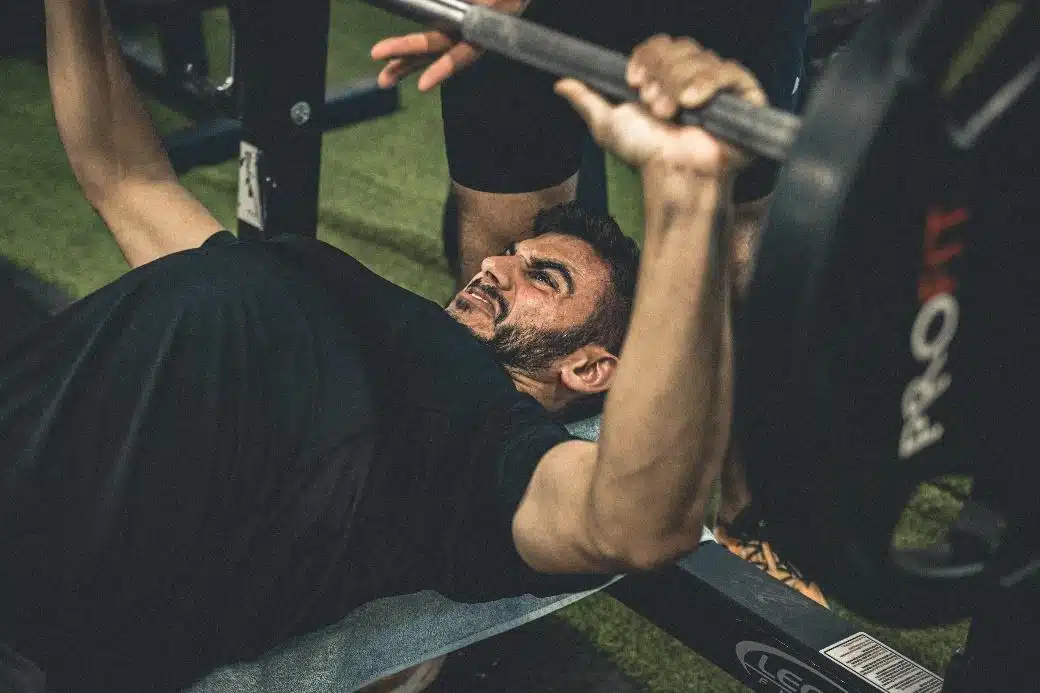
Verkhoshansky and Siff coined the term “quasi-isometric eccentric contractions” (Verkhoshansky & Mel, 2009), also known in English as “yielding isometric,” which roughly translates to “yielding isometrics,” “sustained isometrics,” or “eccentric isometrics” (Schaefer & Bittmann, 2017). The latter term is somewhat complex because it’s like saying something is “black white,” given that isometry involves no movement, whereas eccentric contractions do. The reason is that quasi-isometric eccentric contractions, the term we’ll use in this article to refer to “yielding isometrics,” can be defined as the action of maintaining a position until isometric failure and resisting the subsequent eccentric phase to the maximum (Oranchuk et al., 2019b).
Modern literature has extensively studied the effects of isometric actions and eccentric contractions on hypertrophic and strength adaptations. However, quasi-isometric eccentric contractions remain relatively unexplored. We will use a comprehensive narrative review from 2019 as the scientific basis to describe how “yielding isometric” contractions affect muscle growth (Oranchuk et al., 2019b). But first, let’s define “overcome isometrics” to understand the difference between them.
Yielding Isometrics vs. Overcoming Isometrics
Overcome isometrics involves performing maximum contractions against an immovable object. In this case, we’re not resisting a force, as we do with quasi-isometric eccentric contractions (yielding isometric), but rather exerting force against a load we can’t move. Isometric “yielding” exercises (resisting an external force) create fatigue and different neuromuscular characteristics compared to isometric “pushing” or overcoming isometrics (exerting force against an immovable object). So, the main difference is that in one, we resist the load, while in the other, we exert force against it.
A clear example of overcome isometrics (exerting force against an immovable object) is pushing against a wall at home that we can’t move no matter how much strength we apply, attempting to pull a truck that won’t budge, or any task in which, no matter how much force we exert, there won’t be movement in our muscles and joints. On the other hand, yielding isometrics (resisting an external force) involve holding a load, such as our own body weight in a pull-up until we can’t continue.
How Are Quasi-Isometric Eccentric Contractions (Yielding Isometric) Performed?
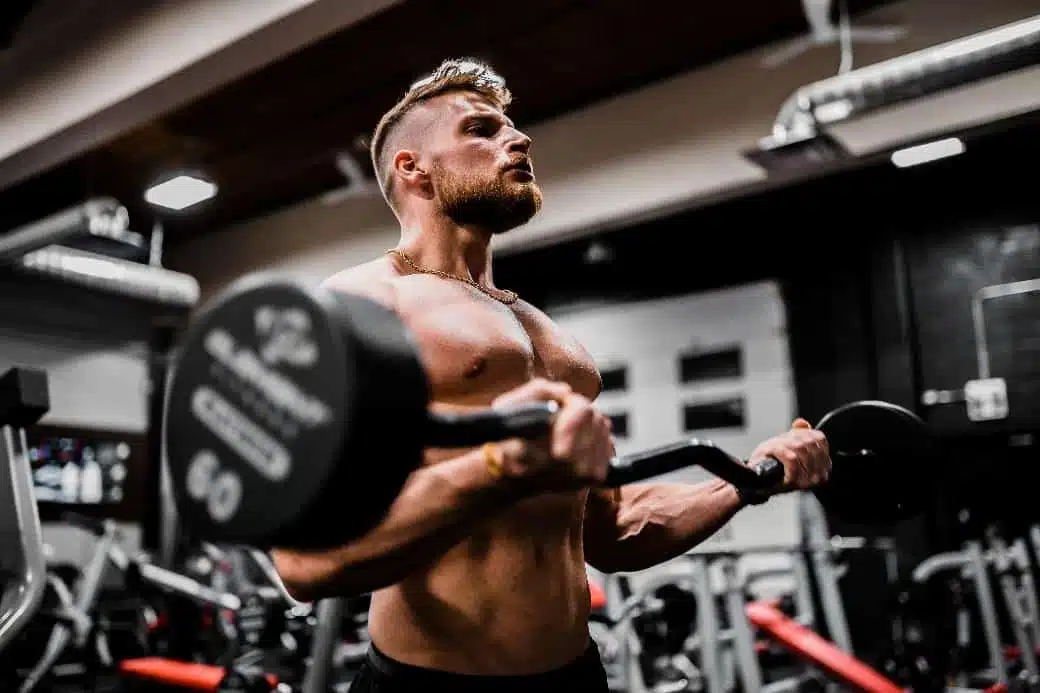
First Step: Select the Load
The range of intensity is quite broad, as with the prescription in dynamic training, there are multiple factors to consider. The recommended intensity for increasing muscle size with quasi-isometric eccentric contractions is 30 to 80% of 1RM (Oranchuk et al., 2019b). These loads allow you to sustain the quasi-isometric eccentric contraction for 5 to 90 seconds, as recommended by experts.
Second Step: Engage the Muscles You’re Training
Once you have the load, you prepare to perform the quasi-isometric eccentric contraction. Before getting to that point, you need to engage the muscles you’re training, for example, the biceps in a barbell bicep curl. In this example, you’ll flex your elbows and lift the bar upward through the full range of motion.
Third Step: Eccentric Contraction Until the Desired Muscle Position is Reached
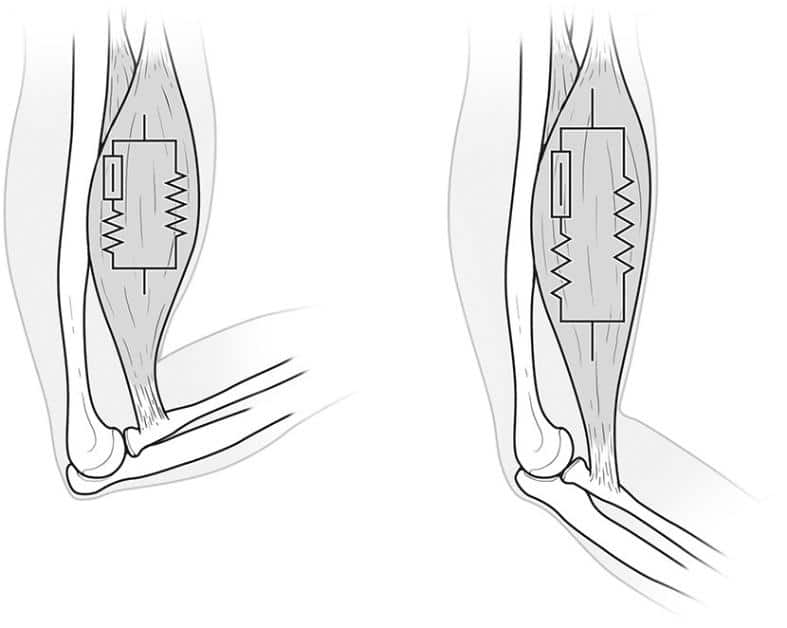
We find ourselves with our elbows flexed in a bicep curl, and the bar at the top. From there, extend your elbows with a normal eccentric contraction until you reach the desired muscle position where you will stop for the quasi-isometric eccentric contraction. In this image taken from (Oranchuk et al., 2019b), we can see the difference between the arm position at a short muscle length (left) and a long muscle length (right). Isometric training at long muscle lengths produces greater increases in muscle hypertrophy than training at short muscle lengths with equivalent volume (Oranchuk et al., 2019a). Therefore, it’s preferable to choose a long muscle length, meaning the muscle is quite elongated.
The reason for this is that when the muscle is in more stretched positions, there is a greater degree of muscle damage and sarcomere distensibility, promoting what’s known as stretch-induced hypertrophy. While it’s true that exercise-induced muscle damage isn’t necessary to promote muscle hypertrophy (Schoenfeld, 2010), emerging research suggests that such muscle damage may play some role in morphological adaptations (Schoenfeld, 2012).
That’s why we should seek elongated positions in this bicep curl exercise we use as an example, and in any other. Once we reach that ideal position, we’ll stop without making any movement and resist the load.
Fourth Step: Hold the Position as Long as Possible and Prevent Being Overcome
Once you reach the prescribed joint position, try to maintain that position for as long as possible. When the load eventually overcomes you, and you can’t prevent it, you should resist to the maximum the muscle lengthening with the intention of keeping the movement speed close to zero, meaning that the movement is practically nonexistent or very slow. Hold the load for as long as you can until you fully extend your arms in the bicep curl example, or complete the elongation of any other muscle in the other exercises.
The recommended loads for this method, ranging from 30 to 80% of 1RM, allow you to sustain the quasi-isometric eccentric contraction for 5 to 90 seconds, as recommended by experts. There isn’t a prescribed duration; it depends on the intensity. Duration and intensity are inversely related variables, meaning that higher loads allow less time under tension, and vice versa.
Are “Yielding Isometrics” or Quasi-Isometric Eccentric Contractions Useful for Gaining Muscle Mass?
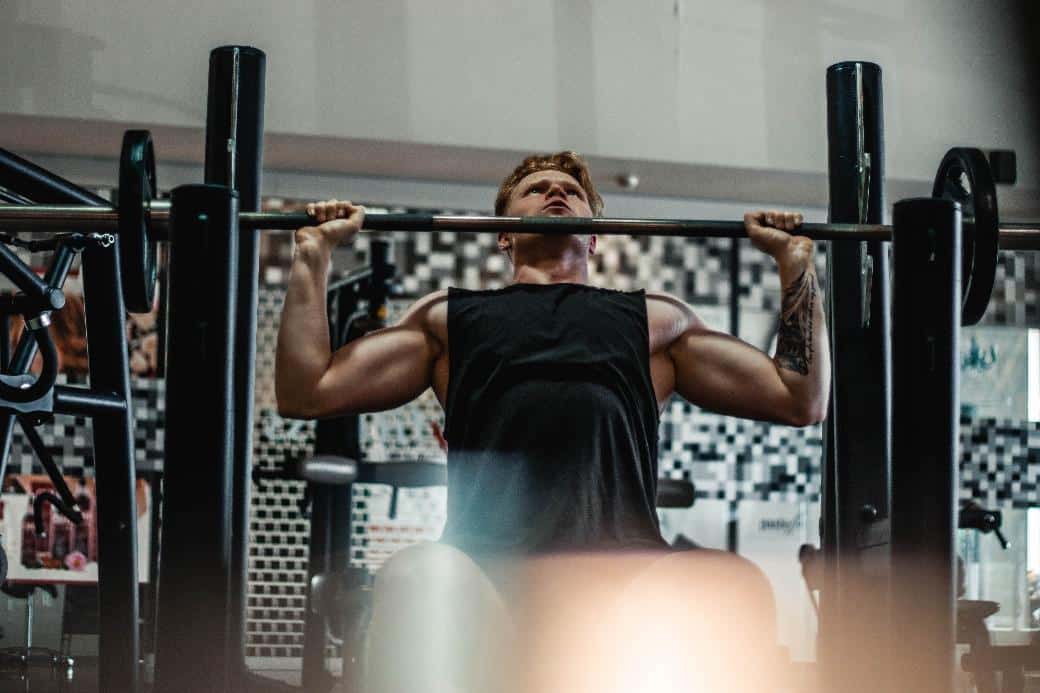
Usually, we train to gain muscle mass by following a dynamic method: each repetition involves both eccentric and concentric phases. In a squat, for example, the eccentric contraction occurs when we bend our knees and lower toward the ground, and the concentric contraction happens as we ascend by applying force upwards.
Of the two phases, the eccentric or stretching phase has been identified as a critical part of the movement for muscle growth. Theoretically, the prolonged quasi-isometric and eccentric component allows for a significant accumulation of mechanical tension and metabolic stress, which can contribute to improvements in work capacity, muscle size, and connective tissue health. Animal models have shown significant gains in muscle hypertrophy by using quasi-isometric eccentric contractions due to their unique stimulus (Ashida et al., 2018).
Mechanical tension is the primary mechanism behind muscle growth, and this mechanism occurs with force generation and stretching, regardless of the type of contraction (Schoenfeld, 2010). Total time under tension, acute hypoxia, and metabolic stress are mechanisms that also contribute to morphological adaptations, all of which can be achieved with quasi-isometric eccentric contractions.
Stretch-loaded training in humans has not been as extensively studied as eccentric and isometric contractions. However, this is changing, and scientific literature is now better understanding the effect of quasi-isometric eccentric contractions on muscle hypertrophy (Apostolopoulos et al., 2015; Herda et al., 2014; Simpson et al., 2017). The potential of this relatively underutilized training strategy is very promising, as shown in the comparative table in the following section.
Comparative Table Between Different Training Methods and Muscle Hypertrophy
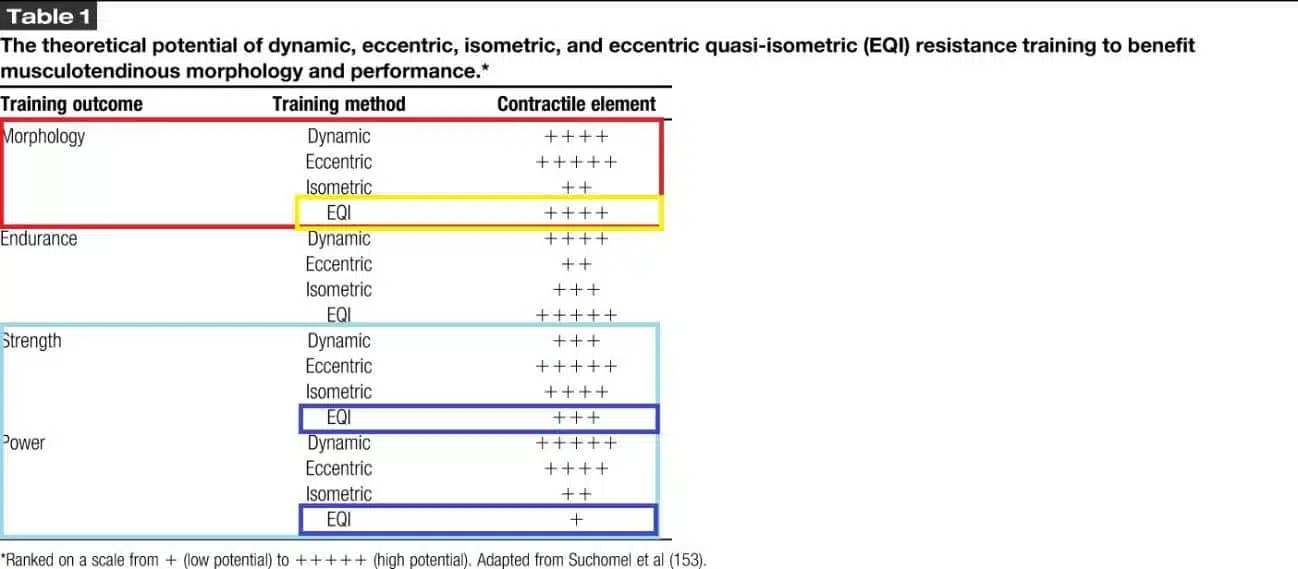
In the table extracted from Oranchuk et al., (2019b), a comparison is made between dynamic training (including concentric and eccentric contractions), eccentric training, classic isometric training, and quasi-isometric eccentric contractions. In the highlighted red section of the table, you can observe that the eccentric phase is crucial for gaining muscle mass, as it has five crosses, the maximum possible. What’s interesting in this comparison is that the dynamic training method also has four significant crosses for gaining muscle mass, just like quasi-isometric eccentric contractions (EQI). Therefore, both training methods are valid for this purpose.
In the light blue highlighted section of the table, the same comparison is made, but for strength and power. In these cases, the use of quasi-isometric eccentric contractions (EQI) appears to be somewhat less effective than the other methods, especially when it comes to improving power, where dynamic training has no rival. The final quality in the table is muscular endurance, where the use of quasi-isometric eccentric contractions (EQI) plays a significant role since it involves sustaining a position for the maximum time.
For example, a speed skater looking to increase muscular endurance in a specific range of motion for skating might experiment with quasi-isometric eccentric contraction training (EQI). In summary, quasi-isometric eccentric contractions seem to be as effective as the traditional training method for developing muscle mass but not as effective for improving strength and power. Much more research is needed to clarify all the variables and the real effect of this strategy, but it can be a great complement to dynamic training.
References
Apostolopoulos, N., Metsios, G. S., Flouris, A. D., Koutedakis, Y., & Wyon, M. A. (2015). The relevance of stretch intensity and position—a systematic review. Frontiers in Psychology, 6, 144223. https://doi.org/10.3389/FPSYG.2015.01128/BIBTEX
Ashida, Y., Himori, K., Tatebayashi, D., Yamada, R., Ogasawara, R., & Yamada, T. (2018). Effects of contraction mode and stimulation frequency on electrical stimulation-induced skeletal muscle hypertrophy. Journal of Applied Physiology (Bethesda, Md. : 1985), 124(2), 341–348. https://doi.org/10.1152/JAPPLPHYSIOL.00708.2017
Herda, T. J., Costa, P. B., Walter, A. A., Ryan, E. D., & Cramer, J. T. (2014). The time course of the effects of constant-angle and constant-torque stretching on the muscle-tendon unit. Scandinavian Journal of Medicine & Science in Sports, 24(1), 62–67. https://doi.org/10.1111/J.1600-0838.2012.01492.X
Oranchuk, D. J., Storey, A. G., Nelson, A. R., & Cronin, J. B. (2019a). Isometric training and long-term adaptations: Effects of muscle length, intensity, and intent: A systematic review. Scandinavian Journal of Medicine & Science in Sports, 29(4), 484–503. https://doi.org/10.1111/SMS.13375
Oranchuk, D. J., Storey, A. G., Nelson, A. R., & Cronin, J. B. (2019b). Scientific basis for eccentric quasi-isometric resistance training: A narrative review. Journal of Strength and Conditioning Research, 33(10), 2846–2859. https://doi.org/10.1519/JSC.0000000000003291
Schaefer, L. V., & Bittmann, F. N. (2017). Are there two forms of isometric muscle action? Results of the experimental study support a distinction between a holding and a pushing isometric muscle function. BMC Sports Science, Medicine and Rehabilitation, 9(1), 1–13. https://doi.org/10.1186/S13102-017-0075-Z/FIGURES/7
Schoenfeld, B. J. (2010). The mechanisms of muscle hypertrophy and their application to resistance training. Journal of Strength and Conditioning Research, 24(10), 2857–2872. https://doi.org/10.1519/JSC.0B013E3181E840F3
Schoenfeld, B. J. (2012). Does exercise-induced muscle damage play a role in skeletal muscle hypertrophy? Journal of Strength and Conditioning Research, 26(5), 1441–1453. https://doi.org/10.1519/JSC.0B013E31824F207E
Simpson, C. L., Kim, B. D. H., Bourcet, M. R., Jones, G. R., & Jakobi, J. M. (2017). Stretch training induces unequal adaptation in muscle fascicles and thickness in medial and lateral gastrocnemii. Scandinavian Journal of Medicine & Science in Sports, 27(12), 1597–1604. https://doi.org/10.1111/SMS.12822
Verkhoshansky, Y., & Mel, S. (2009). Supertraining. 6th ed.

